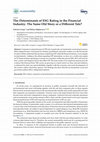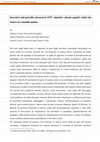Papers by fabrizio crespi
The Funding Strategies of Italian Banks: The Importance of Bonds
The analysis of the funding strategies adopted by the Italian banks over the last ten years confi... more The analysis of the funding strategies adopted by the Italian banks over the last ten years confirms the trends observed for the banks operating in the major European countries. Indeed, since late 2012 deposits have been steadily growing, the weight of bonds, compared to the liabilities, has sharply declined. We find that, after a peak of 11% reached in 2011, at the end of 2016 the share of households’ wealth invested in banks’ bonds was around 3.3% only. Furthermore, until 2007 banks were used to place the majority of their bonds to households. After a steady decline throughout the years, at the end of 2016 only 25% of bank bonds appeared to be in retail investors’ portfolios. Overall, this underscores the key role played by the banks in guiding households’ investments decisions.

Sustainability, Aug 8, 2020
Corporate social performance (CSP) and, in particular, environmental, social and governance (ESG)... more Corporate social performance (CSP) and, in particular, environmental, social and governance (ESG) ratings became a focal point for scholars, practitioners and policy makers over the last decade. In order to better understand the dynamics underlying CSP within the financial industry, we investigate its determinants. Adding to the debate regarding CSP antecedents, we draw on a worldwide sample of 727 financial firms operating in twenty-two countries within the period 2006-2017 and look for firm, country and temporal factors that affect CSP. The main results of our empirical analyses provide evidence that financial firms' ESG scores are growing on a linear trend over time, and such tendency is enhanced by their size and profitability, together with the economic and social development of the country within which they operate. Our findings also show that the environmental, social and governance pillars follow independent patterns.
La comunicazione delle banche italiane nei confronti dei soci: i risultati di una ricerca empirica
Social Science Research Network, 2011
Advocates of diversifying bank income sources often argue that diversification improves the resil... more Advocates of diversifying bank income sources often argue that diversification improves the resilience of banks during periods of distress. To test this proposition, we analyze the impact of income diversification on the performance of Italian banks during the recent financial crisis. Using detailed data on the composition of bank income, we show that institutions that were diversified within narrow activity classes before the crisis experienced large declines in performance during the financial crisis. By contrast, diversification across broad activity classes, such as lending and capital market activities, did not cause performance losses during the crisis. Our results support limiting banks' ability to diversify within narrow business lines, while permitting banks to diversify across broader activity classes.

The Funding Strategies of European Banks: A Discussion
Springer eBooks, Dec 1, 2017
The financial turmoil occurred during the last decade has heavily affected the stability of the f... more The financial turmoil occurred during the last decade has heavily affected the stability of the financial systems and the European economy. Indeed, the implications generated by the crises on the real economy, along with the important regulatory changes affecting banks, have surely had an impact on the behaviour of European banks in regards to their approach towards funding. The analysis of aggregated data for the last ten years confirms the widespread view in the literature that, at least for the largest European economies, retail deposits have acquired an increasing importance in terms of main funding instrument available to the credit institutions. Indeed, banks have progressively replaced wholesale funding in favour of deposits. Moreover, our analysis highlights a decline in the volume of bonds issued by the financial institutions over the last few years.

The Different Types of Bonds Issued by Italian Banks: An Overview
In this Chapter we provide a description regarding the characteristics of the bonds issued by Ita... more In this Chapter we provide a description regarding the characteristics of the bonds issued by Italian banks, as well as the rules governing the issuance of debt instruments. By employing data from a comprehensive database including 9,160 outstanding bonds, we show that banks, in Italy, typically issue plain vanilla bonds. Moreover, provided that the majority of bonds are unlisted, we infer that banks in Italy have been historically used to place their debt securities to retail customers directly at their branches. Finally, using real examples of debt securities currently held by retail investors, we illustrate some innovative structures of bank bonds. The complexity behind these structures suggests that retail investors are probably unaware of the implicit risks of the bonds, because they normally tend to buy (upon trust) what the bank proposes.
Open-end mutual funds listing: the perspectives for the Italian market
BANCARIA, Jul 1, 2016
Introducing Individual Savings Accounts to sustain the development of Italian Smes
BANCARIA, Apr 1, 2017
The Individual Savings Accounts (Pir) have been introduced in Italy via the 2017 Government budge... more The Individual Savings Accounts (Pir) have been introduced in Italy via the 2017 Government budget Law (Legge di Bilancio 2017). Since their announcement, Pir have received a warm welcome by Italian financial intermediaries that are trying their best to spread such new product among investors. Much is known on their fiscal advantages. However, some considerations about their impact for the growth of Italian Smes – as desired by the policy maker – are still needed. Our paper offers some general insights about this topic and provides, as well, a brief summary of the key characteristics of the existing Pirs
Bank Funding Strategies: The Use of Bonds and the Bail-in Effect
La quotazione dei fondi aperti: prospettive di sviluppo per il mercato italiano
L’utilizzo del reverse mortgage nell’ambito del personal financial planning: un’occasione mancata (o ancora da sfruttare) per il mercato italiano?

Il Nuovo accordo di Basilea: le ricadute sull'operatività del sistema bancario e sul rapporto banca-PMI
Le nuove norme di Basilea introducono il rating delle imprese e sono state elaborate con l'ob... more Le nuove norme di Basilea introducono il rating delle imprese e sono state elaborate con l'obiettivo di provocare una profonda modificazione nel rapporto fra banche e imprese. Tale rapporto, ora pi\uf9 conflittuale che cooperativo, e comunque caratterizzato da sostanziali asimmetrie informative fra le parti, dovrebbe andare nella direzione della collaborazione strategica fra i soggetti. Il lavoro di ricerca presentato in questo libro vuole fornire strumenti utili in questa direzione ed \ue8 dedicato in parti colar modo alle PMI della provincia di Lecco e della Brianza. L'analisi \ue8 stata articolata su tre livelli: \u2022 studio dei potenziali effetti dei nuovi accordi di Basilea sugli istituti di credito e sugli enti debitori; \u2022 analisi puntuale del tessuto produttivo della Provincia di Lecco e della Brianza e della loro situazione effettiva in materia di finanza e accesso al credito bancario; \u2022 elaborazione di strumenti informatici da mettere a disposizione delle imprese al fine di meglio comprendere le problematiche connesse alle norme di Basilea 2 e comunque utili a fini di benchmarking e autovalutazione
I PIR per il finanziamento delle PMI: potenzialità di sviluppo del mercato
SIstemi finanziari esteri e modelli organizzativi: il caso della Germania, della Spagna e della Francia

Nel corso degli ultimi anni si è registrato da parte degli investitori (soprattutto istituzionali... more Nel corso degli ultimi anni si è registrato da parte degli investitori (soprattutto istituzionali, ma anche retail) un crescente interesse per l'investimento in materie prime, considerati gli effetti benefici che tale tipologia di investimento è in grado di apportare in termini di diversificazione di portafoglio, così come diffusamente attestato dalla letteratura in ambito accademico 1 : grazie alla loro bassa correlazione con le altre principali asset classes, alla capacità di protezione del capitale contro spirali inflazionistiche, e ai particolari rapporti tra domanda/offerta per alcune di esse, le materie prime permettono infatti di ottenere combinazioni di rischio-rendimento più efficienti, anche e soprattutto durante i periodi di crisi finanziaria. Ma come è possibile investire in materie prime? In passato, e fino a qualche anno or sono, uno dei maggiori ostacoli all'inserimento di quote di materie prime in un portafoglio finanziario, specie se di un investitore retail, è stata proprio l'accessibilità alle medesime. In effetti, una delle migliori modalità per accedere al mercato delle materie prime consisterebbe nell'acquisto diretto delle stesse nel mercato fisico (physical market). Tuttavia, anche trascurando i costi legati allo stoccaggio, l'investimento fisico è possibile, in teoria, solo per alcune materie prime non deperibili. Per ovviare a tale problema, una delle principali soluzioni offerte dal settore finanziario, e adottata in particolare da investitori istituzionali, arbitraggisti e speculatori, consiste nell'investimento in strumenti derivati, quali contratti futures, trattati ormai da anni in mercati altamente liquidi ed efficienti. La gestione di posizioni finanziarie in futures risulta però particolarmente complessa a causa della presenza di meccanismi di marginazione che prevedono la quotidiana regolamentazione dei guadagni e delle perdite presso la stanza di compensazione (clearing house): si tratta, ad evidenza, di una modalità operativa poco praticabile per l'investitore retail. Per rispondere quindi all'esigenza d'investimento in materie prime anche da parte del piccolo investitore, l'ingegneria finanziaria ha risposto attraverso la creazione di particolari strumenti
The Bail-in Effect: How the Cost of Funding Through Bonds has Changed After the Introduction of the BRRD
Bank Funding Strategies, 2017
By employing data from a unique hand-collected dataset, in this Chapter we show that, since the a... more By employing data from a unique hand-collected dataset, in this Chapter we show that, since the adoption of the BRRD in the European Union, Italian banks—probably motivated by the need to increase the appeal of their bail-inable debt instruments—have been forced to offer higher yields (compared to the yields offered by government securities with corresponding maturities) to bondholders, with the consequence of an increase in their cost of funding. Finally, we conclude this final Chapter by offering some very recent examples about the application of the BRDD rules in Italy—which have either led to liquidation, resolution, or precautionary recapitalization cases—and the related side effects generated to bank bondholders.
Incapability or Bad Luck? Testing the “Bad Management” Hypothesis in the Italian Banking System
Using specific evidences from the Italian banking sector and following a microeconomic approach, ... more Using specific evidences from the Italian banking sector and following a microeconomic approach, in this chapter we test the “bad management” hypothesis first introduced by Berger and Deyoung (1997), which suggest that poor managerial practice causes an increase in problem loans after a lag. The chapter gives a contribution to the existing literature in this field, in that it investigates nonperforming loans (NPLs) and other soured loans jointly. Our results confirm the “bad management” hypothesis, in that we discover a positive (lagged) relation between the value of past due/overdrawn loans and NPLs which, in a management perspective, indicates the incapability of the credit manager to anticipate or to recover (at least partially) problematic credits.
Introducing Individual Savings Accounts to sustain the development of Italian Smes
The Individual Savings Accounts (Pir) have been introduced in Italy via the 2017 Government budge... more The Individual Savings Accounts (Pir) have been introduced in Italy via the 2017 Government budget Law (Legge di Bilancio 2017). Since their announcement, Pir have received a warm welcome by Italian financial intermediaries that are trying their best to spread such new product among investors. Much is known on their fiscal advantages. However, some considerations about their impact for the growth of Italian Smes – as desired by the policy maker – are still needed. Our paper offers some general insights about this topic and provides, as well, a brief summary of the key characteristics of the existing Pirs

The Funding Strategies of European Banks: A Discussion
The financial turmoil occurred during the last decade has heavily affected the stability of the f... more The financial turmoil occurred during the last decade has heavily affected the stability of the financial systems and the European economy. Indeed, the implications generated by the crises on the real economy, along with the important regulatory changes affecting banks, have surely had an impact on the behaviour of European banks in regards to their approach towards funding. The analysis of aggregated data for the last ten years confirms the widespread view in the literature that, at least for the largest European economies, retail deposits have acquired an increasing importance in terms of main funding instrument available to the credit institutions. Indeed, banks have progressively replaced wholesale funding in favour of deposits. Moreover, our analysis highlights a decline in the volume of bonds issued by the financial institutions over the last few years.










Uploads
Papers by fabrizio crespi